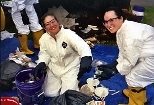People in MIT's offices and dorms could dramatically reduce both the amount of waste generated on campus and the cost of taking it away, according to MIT's first waste audit. Among the key findings: as much as 80 percent of the material thrown out as trash at the Student Center could have been recycled.
On three consecutive Tuesdays last fall, student and staff volunteers went through three-quarters of a ton of trash from New House, the Stratton Student Center and an academic office building. Wearing protective coveralls, heavy gloves and safety goggles, they separated and weighed the trash in different categories--paper, plastic, glass, cardboard, food waste, computers, etc. A team of undergraduates presented data from the audit at a Feb. 4 seminar sponsored by the Laboratory for Energy and the Environment.
The students noted several opportunities both for increasing recycling and for reducing the overall volume of trash. For example, New House residents could recycle twice as much trash as they do now, bringing their overall recycling rate up to 50 percent. (Recycling rate is the mass of material recycled as a percentage of total waste.) Much of the non-recyclable waste was organic material. If New House composted that material, only 20 percent of its overall solid waste would be considered trash.
At the Student Center, the non-recyclable material included a substantial amount of polystyrene food containers and drinking cups, both of which could be replaced by reusable or recyclable materials. Potential gains are significant, as the Student Center is the third-largest trash generator by volume on campus.
In the office waste sample, paper actually outweighed the real trash in the sample; recycling it would have cut the amount of office trash in half.
Though a longer and more comprehensive audit will be needed to get an accurate picture of the MIT community's recycling behavior, the three-day pilot exercise demonstrated several steps that should be taken, the students said.
A top priority is to help people understand and use MIT's existing recycling programs. The students suggested special events, freshman orientation activities, and print and radio advertising. These efforts should encourage people to get and use recycling bins, to buy environmentally friendly products, and to adopt simple but important habits such as two-sided copying.
"We believe every member of the community needs to take the initiative, because real change depends on individual behavior," said freshman George Yong. "We must help people understand and use MIT's existing recycling programs and create an awareness of MIT's attempt to achieve sustainability."
Freshman Jonathan Tejada stressed the importance of taking action in the dorms. "For many students, this is the first time that they've lived on their own," he said. "It's a good time to teach them recycling habits that'll remain throughout their lives."
The financial savings from increasing recycling and reducing campus waste could be considerable. MIT has pledged to share the City of Cambridge's goal of achieving a 40 percent recycling rate by 2005. Recycling 40 percent of MIT's trash would reduce the Institute's $1 million annual waste-management budget by about 10 percent. MIT's annual recycling rate for 2003 was 22 percent--double its rate in 2000.
Norman Magnuson, operations manager in Grounds Services, noted that the pilot waste audit has already inspired MIT to action. The Department of Facilities has recently installed cardboard balers in the Student Center, added more compactors and dumpsters for cardboard and mixed paper, and performed its own initial waste audit of a dumpster containing five tons of trash--half of which could have been recycled. Facilities is now planning four more waste audits beginning in April.
The student waste audit was the core activity of the freshman advising seminar "Achieving MIT's Environmental Goals," taught jointly by the Laboratory for Energy and the Environment and the Environmental Programs Office during fall 2003. The audit was supported by the Environment, Health and Safety Office; Facilities; WasteCap of Massachusetts; and the Campus Activities Center.
For more information on recycling at MIT, see http://web.mit.edu/environment/ourpart/where_you_live/on_campus and http://web.mit.edu/facilities/www/recycle. Or contact Kevin Healy, recycling coordinator for Facilities and a member of the Environmental Programs Task Force, at 253-6360 or recycling@mit.edu.
A version of this article appeared in MIT Tech Talk on February 11, 2004.






